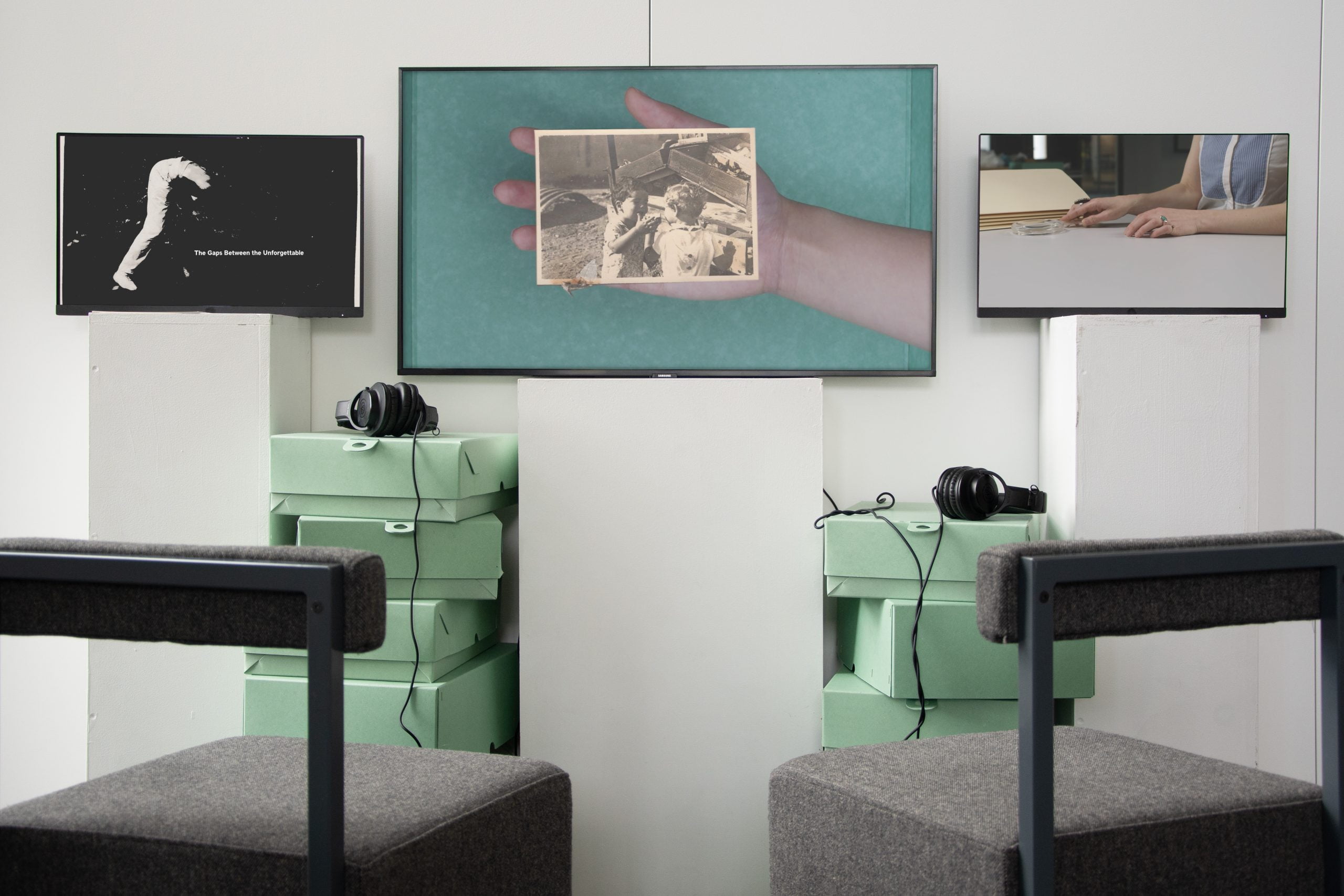“…One of the most heart-breaking things me and my husband experienced (we are both Jewish) when visiting Holocaust Centre North, is that we grew up knowing people of that generation…warm, strong, stubborn, funny, older Jewish people…Our children won’t get to hear their stories first-hand…we have to keep finding ways to reach people with…trust, to talk about it again and again…and art is a great way to do this…”
-Irina Razumovskaya
one of the 2024 Memorial Gestures: Artists-in-Residence
Holocaust Centre North’s collection is a precious time capsule. Based at the University of Huddersfield, it’s one that tells life-affirming stories of survivors of Nazi persecution starting fresh lives in the North of England but one that reminds us of the horrors of war. One that helps quash Holocaust denial conspiracies and cements eyewitness experiences. Holocaust Memorial Day (27th January) reminds us of humanity’s far too recent failings, of how our sight gets clouded, of how respect, love and protection are thrown away without foresight.
‘Memorial Gestures’ was initiated for preservation; an artistic residency to creatively respond to letters, telegrams, toys and photographs in the centre. Over the next nine months Maud Haya-Baviera, Irina Razumovskaya, Ariane Schick and Matt Smith will be researching, giving talks, workshops and tutorials before exhibiting their final pieces in September. Although their tenures have barely begun, the artists gave me some insight into what they hope to achieve.

Portrait of Irina Razumovskaya. (Courtesy of Holocaust Centre North)
London-based Russian-Israeli artist and sculptor Irina Razumovskaya reflected on how we view the Holocaust through modern lenses: “…Society has changed a lot…we have different norms, ethics, and expectations of behaviour…it is important to reinterpret globally significant events…through the eyes of a new generation. And I think this is one of the roles in society for artists, including myself, to each offer our own unique perspectives…”. Irina has had her sculptures exhibited in collections at Chatsworth House, Mashiko Museum of Ceramic Art in Japan and the Icheon World Ceramic Center in Korea (to name a few) and is a tutor at the Royal College of Art in London. Always focusing on the stories of women and choice to become a mother, so far she’s been circling around the topics of “belonging and home and Jewish community” but also “trust and distrust and how it manifests in everyday life”.
Her art is aiming to raise many questions – some which may never get answered, some which broaden her viewers’ mindsets. With ceramics as her forte, irresistible crumbling and deteriorating textures are her trademark, commenting on the ever-changing culture surrounding it. It’s this approach to storytelling that chimes with what the residency has set out to do – remembrance through innovation: “…I find that a lot of mentions of [the] Holocaust in popular culture paint a picture with broad brushstrokes, and more nuanced art projects could open the door to a far more interesting discussion…”.

Matt Smith’s work displayed. (Courtesy of Holocaust Centre North)
Also aiming to adjust these broad brushstrokes is Matt Smith whose interest in unearthing LGBTQ stories and perspectives appears to be fuelling his residency. “…The Holocaust affected a number of groups which do not pass information on to vertical parent/child relationships, including gay men and the disabled…So to some extent, their stories have been less discovered and are ready for re-examination…”. Smith, who holds a PhD in Queer Craft, has had his work held at the V&A, the Walker Art Gallery, the National Museum Oslo and the National Museum of Northern Ireland. Never one to rest on his laurels, Smith’s bold and unpredictable pieces merge contemporary thinking with traditional form, namely re-evaluating what ‘celebrity’ means in ‘Parian Unpacked’ and ‘Losing Venus’.
Filling in missing pieces looks like the path Smith will be taking and this signature investigative approach could pave the way for the centre uncovering new testimonies and stories surrounding less represented groups. He says, “…these are the histories that are absent in the archive at Holocaust Centre North – not for any sinister reason but rather that these were histories outside of life experiences of the people interviewed…”.

Maud Haya-Baviera, Brewers Towner International, 2022 (Image Credit: Rob Harris)
Also hoping to uncover new ground is French artist Maud Haya-Baviera who’s already connecting dots between her life and those told within the collection: “…I am the granddaughter of a political refugee who survived the horrors of concentration camps. There were many concentration camps peppered all over Europe, but this is not well known…I hope to find voices and traces of memories that echo my own family experience…”. Spanning a variety of media – video, photography and sculpture – she always seeks to reshape perceptions with searing undercurrents (‘Things Fall Apart’, 2022 and ‘Wish you were here’, 2020). Like Matt Smith, her passion for unpacking the truth comes first, pinning a Twilight Zone twist beneath the unassuming. Her recent exhibitions include Postnatures (until Dec 2024), Brewer Towner International (2022/23), Aggregate (2022) and Heavy Water (2021).
“…I am not sure human beings learn from former times…” she frankly elaborates, “…but digging into narratives related to the Holocaust and mass suffering must address what makes us human, our sense of empathy…”. Though it is a damning summation there’s no doubt that complacency has a role to play in needing ‘Memorial Gestures’ to keep experiences alive, reinvigorate conversation and challenge mindsets because, as Haya-Baviera says, “…without this…learning is impossible and conspiracy theories are allowed to flourish…”.
London-based Ariane Schick whose work explores how we recount memories has felt drawn towards the themes of, “…hope, love [and] the drive to carry on and other ‘big notions or emotions’ that get held or shared in the form of very small items…compression, weight, strength [and] deformation…”. Fuelled by the intuition of the subconscious, her pieces often feature faded mark-marking and off-white tones. A haziness blocking out details. Schick said, “…I have liked how inclusive the archive is of material from before and after the war…this gave me a more expanded impression of the people included…” – a love of restoring the past through sculpture, text, video and sound will shine through her final piece come September.

‘These Were Not Simple Deaths’, Jordan Baseman. (Courtesy of Holocaust Centre North)
The inaugural residency saw Jordan Baseman, April Lin 林森 and Laura Fisher produce textiles, print and sound installations on the strength of family, intergenerational ties and the link between the present and the past. Baseman’s award-winning short film ‘These Were Not Simple Deaths’ used ghostly, nighttime footage of trees to visualise Lillian Black OBE’s narration that reminisced about her father, Eugene Black, a survivor of Bergen-Belsen. Laura Fisher traversed textiles, embroidery, drawing and monoprints, assembling three pieces of hope. ‘Red Cross Blankets’ stands out as a celebration of humanitarianism; though its unnerving context still remains, the optimism of camaraderie cuts through. ‘The Gaps Between the Unforgettable’ by April Lin 林森 captured footage of items in the archives spread across three screens with an emphasis on negative space, exploring postmemory and legacy.

Works of April Lin 林森. (Courtesy of Holocaust Centre North)
Opening in September, the second instalment of ‘Memorial Gestures’ will directly address growing concerns that the tragedy of these events will soon fade into obscurity. With fewer and fewer living eyewitnesses and a growing sense of abandonment from young people, the Holocaust Centre North faces the possibility that future generations may not know, understand or feel the weight of what happened. Educating through artistic discourse will spark conversation. And sparking discussion will breathe awareness of one of history’s vilest chapters.




Comments